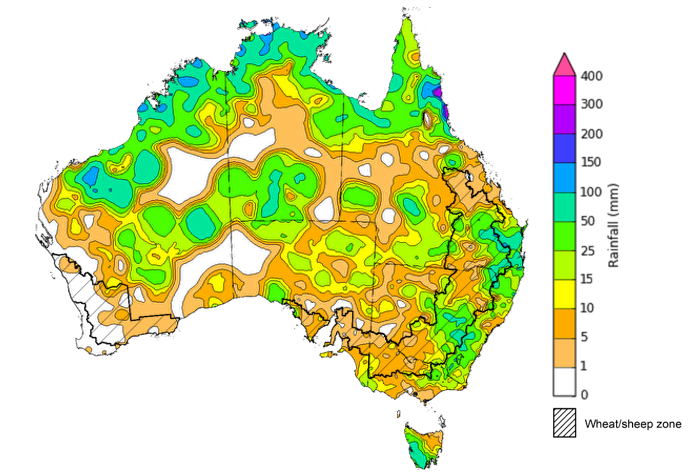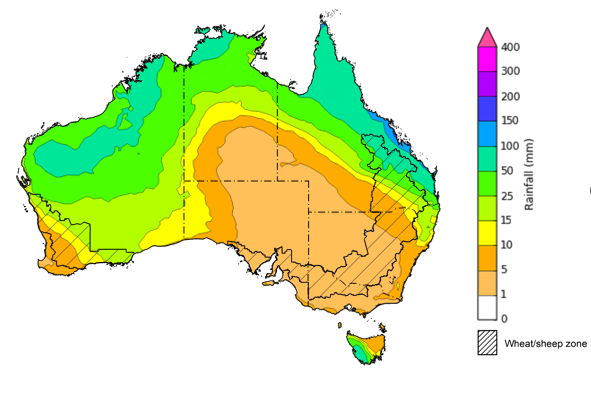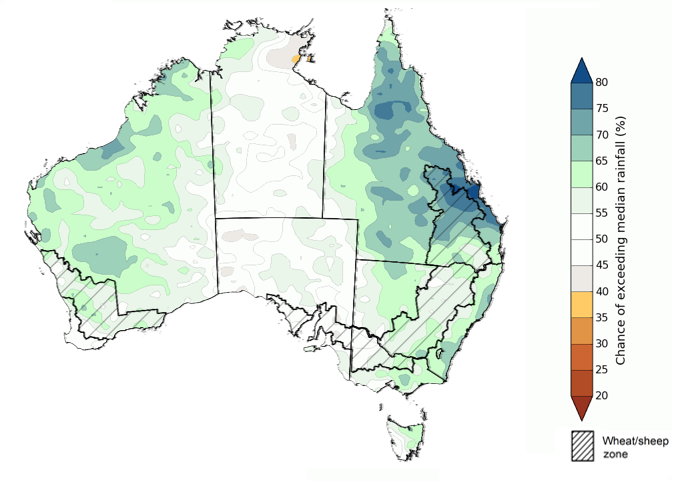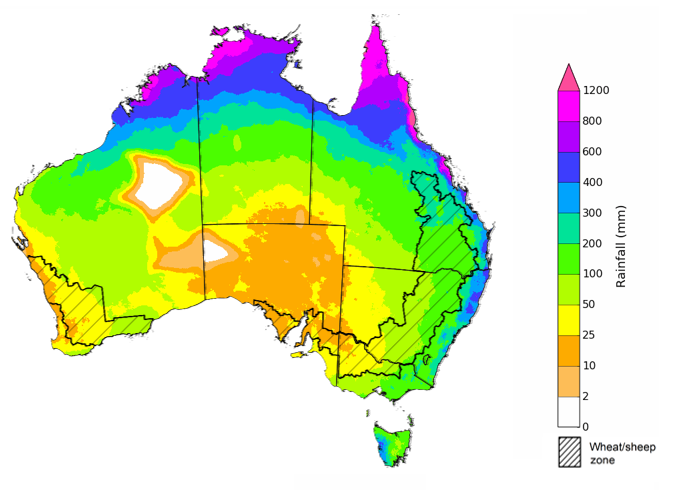Key issues
- In the week ending 11 December 2024, low-pressure systems brought rainfall to every state and territory.
- Many cropping regions across eastern Australia recorded significant rainfall totals this week. Totals of between 10 to 100 millimetres were recorded across large areas of Queensland and New South Wales.
- Conditions across southern and western cropping regions of the country were drier, generally receiving 0 to 10 millimetres of rainfall.
- For eastern areas that recorded significant rainfall this week, this has likely delayed the harvest of remaining winter crops, but will provide a boost to soil moisture levels benefitting summer crop production in Queensland and pasture growth in central New South Wales.
- Over the coming days, low-pressure systems are expected to bring rainfall across the west and north of the country.
- Across cropping regions, much of Queensland is expected to record falls of between 10 and 100 millimetres. Meanwhile, falls of between 5 and 10 millimetres are forecast for much of South Australia, New South Wales and Victoria. Western Australia is likely to see between 5 and 25 millimetres.
- The national rainfall outlook for January to March 2025 indicates an increased probability of above median rainfall across the east and west of the country.
- There is a 75% chance of rainfall totals being between 100 and 200 millimetres across most eastern cropping regions, with higher rainfall expected in Queensland and northern New South Wales. In southern and western areas of eastern regions, rainfall totals of between 25 and 50 millimetres are expected. If realised, these rainfall totals should improve soil moisture profiles, support summer pasture growth and provide a boost to soil moisture profiles and maintain above yield expectation for summer crops in Queensland and northern New South Wales.
- Water storage levels in the Murray-Darling Basin (MDB) increased between 05 December 2024 and 12 December 2024 by 239 gigalitres (GL). Current volume of water held in storage is 16 541 GL, equivalent to 74% of total storage capacity. This is 16 percent or 3,106GL less than at the same time last year. Water storage data is sourced from the Bureau of Meteorology.
- Allocation prices in the Victorian Murray below the Barmah Choke increased from $119 on 5 December 2024 to $144 on 12 December 2024. Prices are lower in regions above the Barmah choke due to the binding of the Barmah choke trade constraint.
Climate
In the week ending 11 December 2024, low-pressure systems brought rainfall and storms to every state and territory. Falls of between 5 and 150 millimetres were recorded across much of the far north of the country, with parts of northern Queensland seeing as much as 300 millimetres. Widespread falls of between 10 and 100 millimetres were recorded across central and eastern areas of the country, including the southern Northern Territory, north-eastern and central regions of New South Wales and Queensland, central Western Australia, northern South Australia, eastern Victoria and western Tasmania. In contrast, high-pressure systems kept the south comparatively dry, with southern Western Australia seeing between 0 and 10 millimetres.
Across cropping regions, rainfall outcomes were mixed, with large areas of Queensland and New South Wales seeing between 10 and 100 millimetres. In the south, rainfall totals were lower, with much of South Australia and Victoria recording between 5 and 10 millimetres of rainfall over the period, and Western Australia remaining largely dry. For those eastern areas that recorded significant rainfall this week, this has likely delayed the harvest of remaining winter crops, but will provide a boost to soil moisture levels benefitting summer crop production in Queensland and pasture growth in central New South Wales.
Rainfall for the week ending 11 December 2024

Issued: 11/12/2024
Note: The rainfall analyses and associated maps utilise data contained in the Bureau of Meteorology climate database, the Australian Data Archive for Meteorology (ADAM). The analyses are initially produced automatically from real-time data with limited quality control. They are intended to provide a general overview of rainfall across Australia as quickly as possible after the observations are received. For further information go to http://www.bom.gov.au/climate/rainfall/
Over the 8 days to 19 December 2024, low-pressure systems are expected to bring high rainfall totals to the west and north of the country, with falls of between 25 and 100 millimetres likely for much of northern and central Western Australia, the north of Northern Territory, northern and eastern Queensland, as well as western Tasmania. A high-pressure system is likely to keep the south-east relatively dry, with New South Wales and Victoria likely to see between 5 and 10 millimetres of rainfall, and South Australia likely to see between 5 and 15 millimetres.
Across cropping regions, rainfall totals are forecast to be low across the southeast, with heavier falls expected in the north and west. Northern and central Queensland cropping regions are forecast to receive between 25 and 100 millimetres of rainfall, while south-western Queensland, New South Wales, Victoria, and South Australia are expected to see little to no rainfall. Across the north and east of Western Australia, falls of between 10 and 25 millimetres are forecast. If realised, the mainly dry conditions across eastern cropping regions will likely support the harvest of remaining winter crops. Rainfall forecast for summer cropping regions in northern Queensland will likely provide a boost for soil moisture levels and support the germination and growth of crops already in the ground.
Total forecast rainfall for the period 12 December to 19 December 2024

Issued 12/12/2024
Note: This rainfall forecast is produced from computer models. As the model outputs are not altered by weather forecasters, it is important to check local forecasts and warnings issued by the Bureau of Meteorology.
The El Niño Southern Oscillation (ENSO) and Indian Ocean Dipole (IOD) climate drivers are currently neutral and having minimal influence on Australian rainfall. The Southern Annular Mode (SAM) is currently negative and is forecast to return to neutral conditions in the coming weeks. A negative SAM contributes to a decreased chance of rain in the summer months across south-eastern Australia.
The most recent rainfall outlook for January 2025 provided by the Bureau of Meteorology indicates that much of eastern Australia, including eastern Queensland and New South Wales, as well as parts of Western Australia are likely to see above median rainfall. For the remaining regions, rainfall is likely to be similar to average.
According to Bureau of Meteorology’s climate model, for January 2025, there is a 75% chance of rainfall totals of between 50 and 300 millimetres across much of the north, including northern Western Australia and the Northern Territory, with parts of northern Queensland likely to see as much as 400 millimetres. Lower rainfall totals are expected across eastern areas, with much of southern Queensland, New South Wales, Victoria and Tasmania likely to see between 5 and 100 millimetres. In South Australia and southern Western Australia, little to no rainfall is expected.
Across cropping regions, there is a 75% chance of receiving between 10 and 50 millimetres of rainfall across much of New South Wales with falls of between 25 and 100 millimetres expected in Queensland. Little to no rainfall is expected across remaining cropping regions.
The relatively low expected rainfall totals across much of southern Australia are typical for this time of year. This is likely to lead to continued low levels of pasture growth and increased turn off of livestock for slaughter. In contrast, if forecast rainfall totals are realised across much of New South Wales and Queensland, these falls are likely to be sufficient to support above average yield prospects for summer crops and average or better levels of pasture production.
Rainfall totals that have a 75% chance of occurring in January 2025
![Map showing the rainfall totals that have a 75% chance of occurring during the next month in Australia. Image provided by the Bureau of Meteorology. Please refer to accompanying text for a more detailed description. For further information, go to http://www.bom.gov.au/climate/ahead/about/.]](/sites/default/files/images/rain.forecast.calib_.scenario.75.national.month1_.latest.hr__47.png)
Issued: 12/12/2024
The rainfall outlook for January to March 2025 indicates an increased probability of above average rainfall across large areas of eastern and western Australia. Much of the remainder of the country is equally likely to receive above or below median rainfall.
Across cropping regions, the chance of receiving above median rainfall is between 55% to 75% across much of Queensland, with New South Wales, Victoria, and Western Australia having a 55 to 65% chance of above median rainfall. In South Australia, the chances of receiving above or below median rainfall are approximately equal.
Rainfall totals that have a 75% chance of occurring January 2025 to March 2025

Issued: 12/12/2024
The outlook for January through to March suggests a 75% chance of receiving rainfall totals of between 50 and 300 millimetres across much of Queensland, New South Wales, southern Victoria, Western Australia, Tasmania, and the Northern Territory. Rainfall totals in excess of 300 millimetres are forecast for the tropical north of Western Australia, the Northern Territory, and Queensland, as well as coastal areas of Queensland and New South Wales and western Tasmania. The far southwest of Western Australia and much of South Australia are likely to receive rainfall totals of between 10 and 50 millimetres over this period.
In summer cropping regions, there is a 75% chance of receiving between 100 and 300 millimetres of rainfall across much of Queensland, and between 50 and 200 millimetres across northern New South Wales. If realised, these forecast rainfall totals are likely to be sufficient to support summer pasture growth across eastern and northern Australia. Additionally, these expected falls are likely to provide a boost to soil moisture profiles and maintain above yield expectation for summer crops in Queensland and northern New South Wales.
Rainfall totals that have a 75% chance of occurring January 2025 to March 2025

Issued: 12/12/2024
Water
Water storages, water markets and water allocations - current week
The Tableau dashboard may not meet accessibility requirements. For information about the contents of these dashboards contact ABARES.
Commodities
Information on weekly price changes in agricultural commodities is now available at the Weekly commodity price update.
